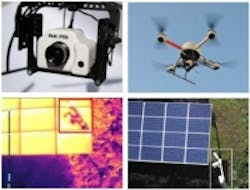Thermal imaging UAVs help identify anomalies in solar plants
Italian unmanned aerial vehicle (UAV) inspection company Panoptes Srl began working with small UAVs in 2009, but after using consumer cameras, soon realized that it would need specialized inspection tasks. Namely, it needed a vision system specifically designed for small UAVs.
As a result, the company released the Panoptes, which is a family of multi-sensor modules coupled with special software designed specifically for small UAVs. The first product in the line was the mini-Thermo multi-sensor platform (mT Panoptes). This compact system was created specifically for use in UAVs inspecting photovoltaic cells in solar plants.
The mT Panoptes is equipped with both thermal imaging and visible light imaging capabilities. A FLIR Tau thermal imaging core is integrated into the mT, providing thermal images of 640 x 512 pixels. Tau cores feature an uncooled VOx microbolometer thermal imager, a 17 µm x 17 µm pixel pitch, a 7.5 µm – 13.5 µm spectral band, and frame rates of 30 Hz (NTSC), and 25 Hz (PAL). The visible light imager features a 1/3" CMOS image sensor, 768 x 576 pixels, and a frame rate of 50 fps. Both imagers are 76 x 52 x 60 mm and weigh less than 200g.
When deployed, the mT Panoptes inspects photovoltaic cells in solar plants. Anomalies in photovoltaic cells and modules can cause a reduced efficiency of an entire system, so periodic maintenance inspections are done to locate these malfunctions. With a thermal imaging camera, the UAV is able to create an image displaying subtle temperature differences, which may indicate a malfunction.
In the past, these inspections may have been done with mobile platforms or helicopters, but the UAVs provide a more efficient method of inspection by capturing both thermal and visual high quality images and video, which is recorded on board. The thermal imaging channel is transmitted in real time to the ground and the data is presented in the Solar Inspector software, which looks for anomalies, and the visible light camera is used as a reference against the thermal imager.
View the case study.
Also check out:
(Slideshow) 10 innovative current and future robotic applications
UAVs create 3D model of the Matterhorn
UAVs guide students around MIT campus
Share your vision-related news by contacting James Carroll, Senior Web Editor, Vision Systems Design
To receive news like this in your inbox, click here.
Join our LinkedIn group | Like us on Facebook | Follow us on Twitter | Check us out on Google +
About the Author

James Carroll
Former VSD Editor James Carroll joined the team 2013. Carroll covered machine vision and imaging from numerous angles, including application stories, industry news, market updates, and new products. In addition to writing and editing articles, Carroll managed the Innovators Awards program and webcasts.
